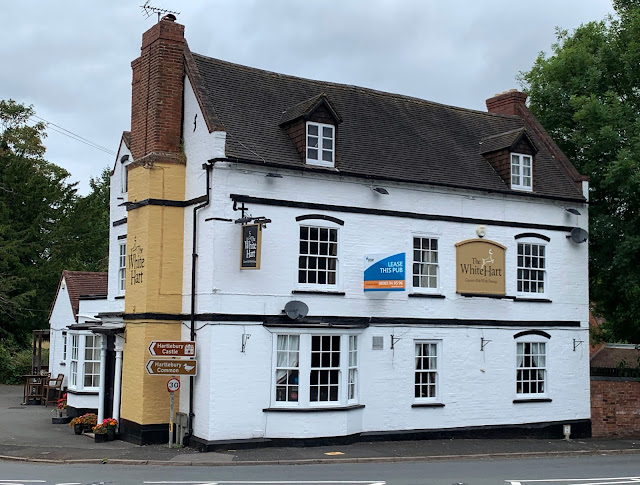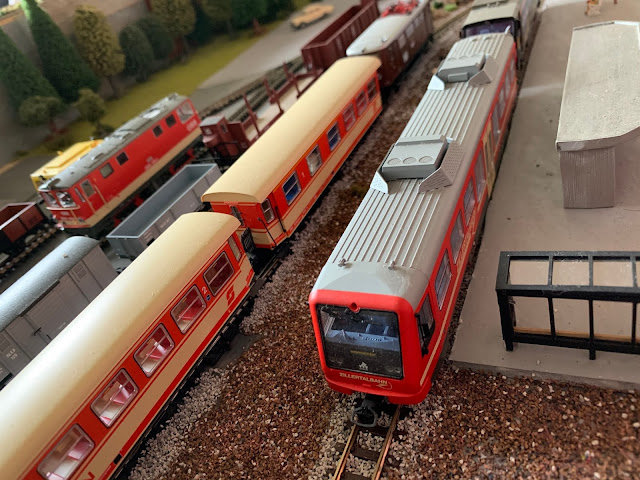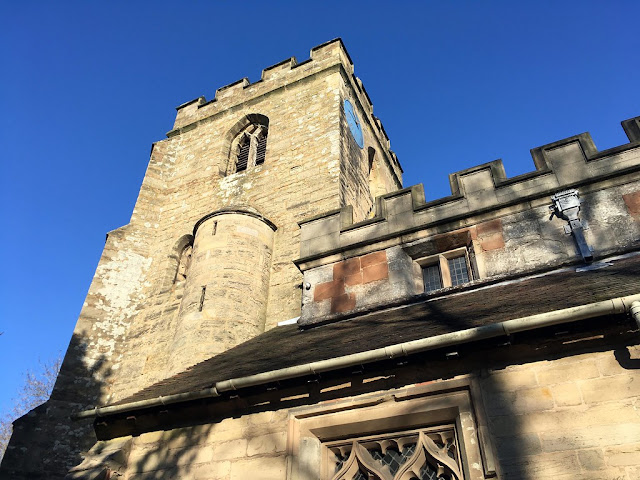This blog has now passed over 1000 posts (in fact this post is number 1002). Of course this is just a number, blog post 1000 need not mean any more than blog post 438 or 743. However it is nice to mark this milestone. This blog serves to chronicle my adventures around the country as well as write about old buildings (especially churches) and other items of interest. Thank you for visiting of course, this blog will be continuing for as long as... well I go anywhere!
Monday 31 August 2020
Saturday 29 August 2020
Model Week : Return of the push-pull
The push-pull coach, one of the original HO9 items bought along with the Falcon, has returned to the layout. We have a bit of a glut of coaching stock in the active fleet at the moment so it likely some other coaches will go into reserve. The freight fleet will also have a bit of a change around.
Friday 28 August 2020
Churches (74) : St Mary and St Bartholomew, Hampton-in-Arden
The parish church of Hampton-in-Arden has Norman origins. The chancel dates from the mid-12th century. The nave and a South aisle built at around the same time or a bit later that century, only part of the aisle remains. A North aisle was rebuilt in the 14th century so may have originally been built as the South one.
The South aisle was rebuilt in the 15th century, the West tower was also built in that century. The tower originally had a tall spire but it was destroyed during a storm on St Andrew's Day 1643. The church was restored in 1879.
The South aisle was rebuilt in the 15th century, the West tower was also built in that century. The tower originally had a tall spire but it was destroyed during a storm on St Andrew's Day 1643. The church was restored in 1879.
Closing at Coseley
An action packed week off work which concluded with a trip to another new station, Coseley near Wolverhampton. I also walked the Wednesbury Oak Loop which is a former part of the Birmingham Main Line canal but nowadays a bit of a dead end! You can see my photos here.
Thursday 27 August 2020
Return to Rugeley
Today I did something which I don't actually do that often these days. I went to a station and stayed there, no churches, no canals, just trains! The station was Rugeley Trent Valley which I first went to a few weeks ago. I enjoyed plenty of variety on the line, though as usual the best thing (a heritage locomotive being hauled down the line) I couldn't photograph because I was on a train at the time! You can see the photos I did take here.
Wednesday 26 August 2020
Widney Manor
Time for another local trip. Today I went to Widney Manor which is on the edge of Solihull. There wasn't a great deal to see there apart from the railway station (there was a park I could have gone to but I didn't feel like walking that far!) However it ticks another railway station off the list. A couple of days ago I compiled a master list of railway stations which I have been to ever. To my surprise it was only just over three hundred. There are over 2,600 stations in the country so I have many more to visit in future! You can see my Widney Manor photos here.
Tuesday 25 August 2020
Before the Big 4 (4) : London, Brighton and South Coast Railway
The London, Brighton and South Coast Railway operated trains from London into Sussex and Surrey, most notably Brighton. The company was formed in 1846 from the amalgamation of five railway companies including the London & Croydon Railway and the London & Brighton Railway. London Bridge was the LB&SCR's headquarters.
The company began a period of expansion but also conflict with rival railway companies. One of these conflicts, with the London & South Western Railway, ended up with the so-called battle of Havant where rival gangs of LB&SCR and LSWR railwaymen blocked the line and may even have fought! Eventually the two companies resolved their differences and shared a direct route to Portsmouth.
The company also expanded into South London and new lines in Sussex and Surrey. However various large capital projects bought the LB&SCR to it's knees in the late 1860s. Luckily for the company a huge growth in London commuter traffic helped restore the company's financial stability.
The company's main locomotive works was at Brighton. The LB&SCR was one of the early adopters of electrification, the South London Line between London Bridge and London Victoria being electrified in 1909. Other routes were also electrified, with DC overhead wiring, though the LB&SCR's successor company the Southern Railway standardised on DC third rail and converted these lines in the late 1920s.
The LB&SCR became part of the Southern Railway in 1923.
The company began a period of expansion but also conflict with rival railway companies. One of these conflicts, with the London & South Western Railway, ended up with the so-called battle of Havant where rival gangs of LB&SCR and LSWR railwaymen blocked the line and may even have fought! Eventually the two companies resolved their differences and shared a direct route to Portsmouth.
The company also expanded into South London and new lines in Sussex and Surrey. However various large capital projects bought the LB&SCR to it's knees in the late 1860s. Luckily for the company a huge growth in London commuter traffic helped restore the company's financial stability.
The company's main locomotive works was at Brighton. The LB&SCR was one of the early adopters of electrification, the South London Line between London Bridge and London Victoria being electrified in 1909. Other routes were also electrified, with DC overhead wiring, though the LB&SCR's successor company the Southern Railway standardised on DC third rail and converted these lines in the late 1920s.
The LB&SCR became part of the Southern Railway in 1923.
 |
| B1 Class at NRM York, the only LB&SCR tender locomotive to be preserved |
 |
| LB&SCR built shed at Tunbridge Wells West |
 |
| A1X class preserved on the Isle of Wight Steam Railway |
 |
| Another view of the preserved B1 class |
Monday 24 August 2020
Five Ways to Edgbaston
I'm not at work this week, instead I have a few trips planned. Today I travelled the short distance to Five Ways station just on the opposite side of the city centre. Then I walked along the canal as far as Birmingham University. It is a nice walk on the canal, alongside the railway. It also includes Edgbaston Tunnel. You can see my photos here.
Sunday 23 August 2020
Looking in Longport
Yesterday I went up to Longport in Stoke-on-Trent. Now this isn't as pretty or scenic as some places I visit being a fairly run down area full of post-industrial decline - just like where I live so I felt quite at home to be honest! I had a good walk along the Trent & Mersey Canal which included a large boat yard, I don't think I've seen quite so many canal boats up on dry land before! My photos at Longport station and some others in the local area can be seen here.
Friday 21 August 2020
Churches (73) : Holy Trinity, Ratcliffe-on-Soar
The Church of the Holy Trinity in Ratcliffe-on-Soar, Nottinghamshire dates from the late 12th or early 13th century and was built on the site of an earlier church that dated from Saxon times. The tower is 13th century but with a 14th century spire. The church has a nave, aisles, South porch and a chancel.
The church was built from ashlar and dressed course rubble with some red brick. The church was restored in 1891.
The church was built from ashlar and dressed course rubble with some red brick. The church was restored in 1891.
Wednesday 19 August 2020
Model Week : The Falcon heads off
The Falcon has headed off to the reserve pool, a.k.a. the storage box! However definite plans are now being made for a small board extension and MPD. The idea is for this to branch off the main loop in the back scene. It's possible up to three sidings, maybe one or two of them having isolated sections to allow for up to five locomotives to be stored.
Tuesday 18 August 2020
Before the Big 4 (3) : London North Western Railway
The London North Western Railway was one of the larger pre-grouping railway companies, indeed for a time in the late 19th century it was the largest joint stock company in the country. The LNWR was formed in 1846 from the amalgamation of Grand Junction Railway, London & Birmingham Railway and the Manchester & Birmingham Railway. This created a single network linking London to Birmingham, Crewe, Liverpool and Manchester - what we consider the core of the West Coast Main Line today.
The company grew (including by further amalgamations) as far North as Carlisle and West into North Wales and the Irish mail trains from Holyhead. Further lines reaches the likes of Leeds, Nottingham and into South Wales. The final amalgamations in 1922, including with the Lancashire & Yorkshire Railway, helped the LNWR reach over 2,700 route miles before it became a core part of the London, Midland & Scottish Railway. The LNWR headquarters were London Euston, still one of the busiest railway stations on the network.
In the early 20th century the LNWR built an electrified line from London Euston to Watford operated by Electric Multiple Units. This line is now part of the London Overground.
The company grew (including by further amalgamations) as far North as Carlisle and West into North Wales and the Irish mail trains from Holyhead. Further lines reaches the likes of Leeds, Nottingham and into South Wales. The final amalgamations in 1922, including with the Lancashire & Yorkshire Railway, helped the LNWR reach over 2,700 route miles before it became a core part of the London, Midland & Scottish Railway. The LNWR headquarters were London Euston, still one of the busiest railway stations on the network.
In the early 20th century the LNWR built an electrified line from London Euston to Watford operated by Electric Multiple Units. This line is now part of the London Overground.
 |
| 790 Hardwicke at NRM Sheldon |
 |
| Crewe, where the main LNWR engineering works were located |
 |
| A preserved Watford DC EMU at NRM York |
 |
| Surviving LNWR badge on a bridge in St Helens |
 |
| Preserved G2 at Shildon |
Monday 17 August 2020
Saturday 15 August 2020
Hinckley
Today I went to Hinckley in Leicestershire, a place I have been through quite a few times but not actually visited until now. It is a nice little town, I am very fond of Leicestershire in general. Hinckley has a nice parish church plus the usual collection of historic buildings. There is a canal too though I did not have time to visit that this time, maybe in future. You can see my photos here.
Friday 14 August 2020
Churches (72) : St Mary Magdalene, Tanworth-in-Arden
The church of St Mary Magdalene in the Warwickshire village of Tanworth-in-Arden dates from the early 14th century. Unlike many churches which have been added to over the centuries, the majority of the building was done in one period, probably in from about 1300 up to the 1330s. The church consists of a West tower with spire, chancel, nave and a North aisle.
There were some changes though. The original arcade was demolished in 1790. The arcade was rebuilt during Victorian restoration in 1880.
There were some changes though. The original arcade was demolished in 1790. The arcade was rebuilt during Victorian restoration in 1880.
Subscribe to:
Posts (Atom)












































